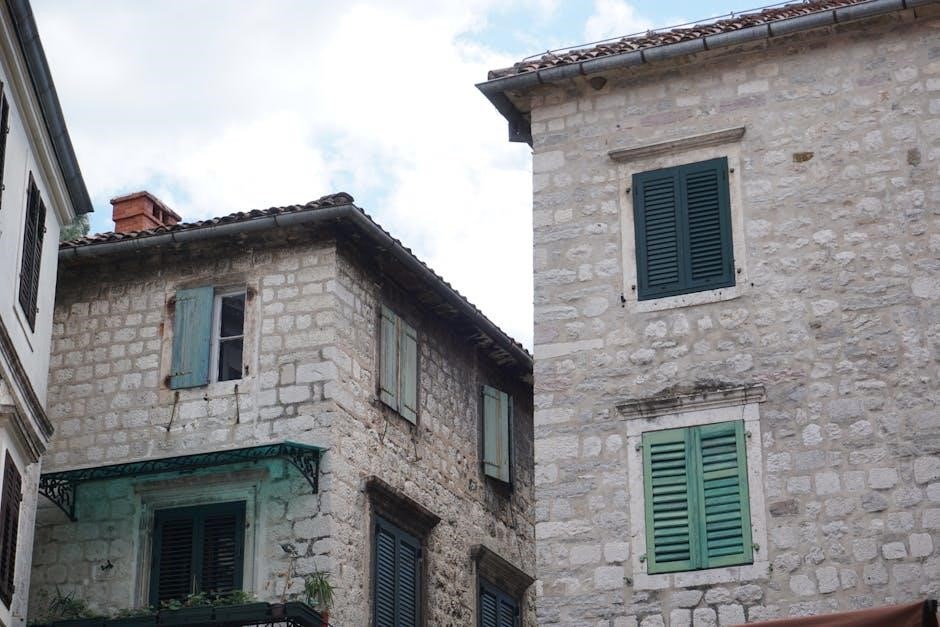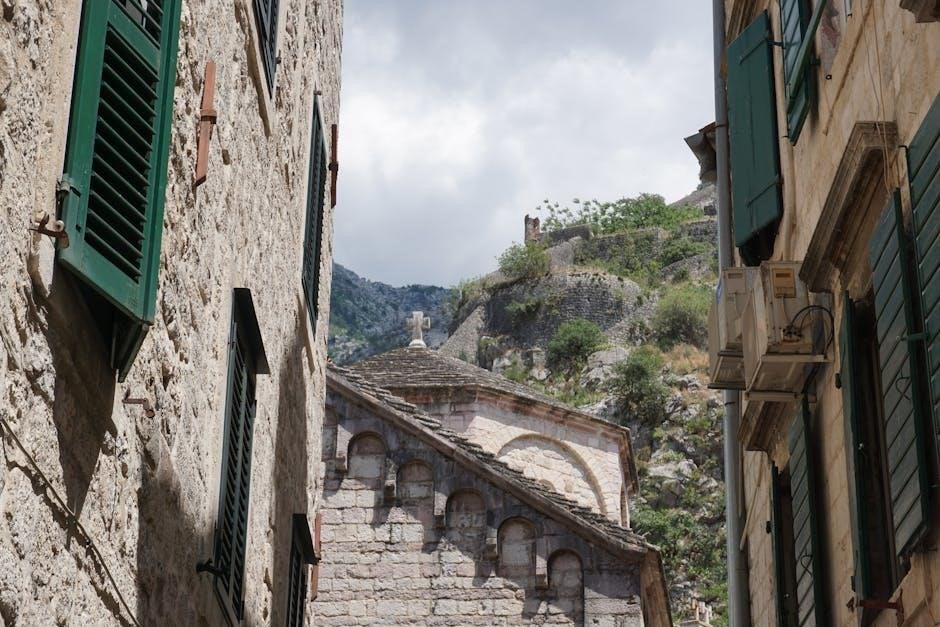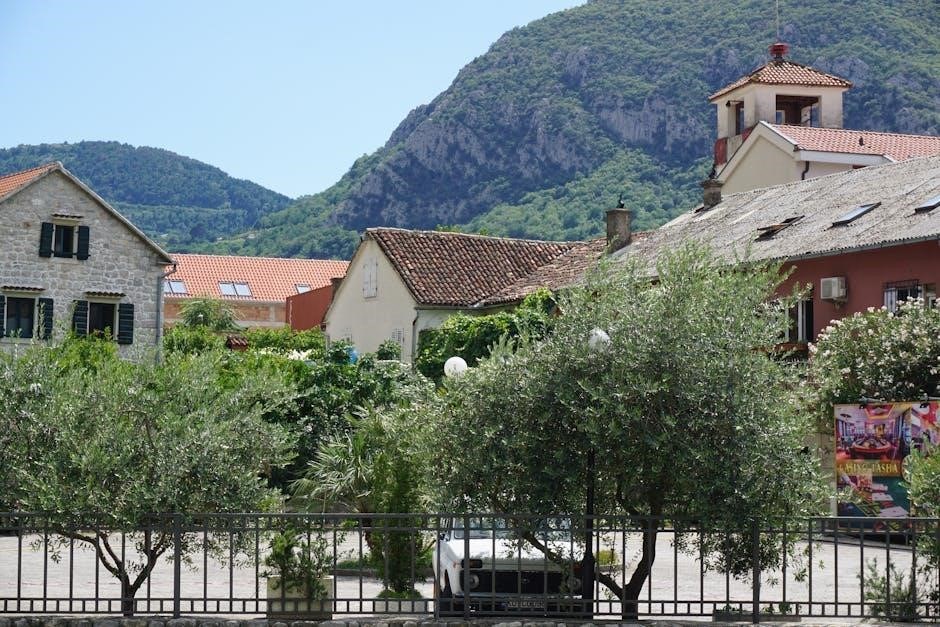Van Richten’s Guide to Ravenloft is a 5e D&D sourcebook that brings horror elements to your game, offering domains of dread, dark gifts, and eerie atmosphere.
Purpose and Overview of the Guide
Van Richten’s Guide to Ravenloft is designed to equip Dungeon Masters with the tools to craft immersive horror-themed campaigns in Dungeons & Dragons 5th Edition. The guide provides a comprehensive framework for creating eerie atmospheres, terrifying encounters, and morally complex narratives. It introduces concepts like Dark Gifts, haunted traps, and the Spirit Board, offering a step-by-step approach to running horror games effectively. While not an adventure path or a traditional setting book, it focuses on empowering DMs to build unique domains of dread, inspired by the iconic Ravenloft setting. The book balances atmosphere, pacing, and mechanics to deliver a chilling experience, making it an essential resource for horror enthusiasts in D&D.
Key Features and Tools for Horror-Themed Games
Van Richten’s Guide to Ravenloft introduces several innovative tools tailored for horror-themed D&D games. The Spirit Board and Tarokka Deck provide unique narrative devices for divination and plot hooks. Dark Gifts grant players haunting abilities, adding a personal touch to horror. The guide also features haunts and curse mechanics, allowing DMs to create lingering, eerie effects. Additionally, it offers tips for building tension, using atmospheric descriptions, and balancing fear with fun. These tools empower DMs to craft unforgettable horror experiences, ensuring players face psychological and supernatural challenges that linger long after the game ends. The guide’s focus on immersive storytelling and mechanical depth makes it indispensable for horror enthusiasts in 5th Edition.

Character Creation in Ravenloft
Van Richten’s Guide to Ravenloft expands character creation with new lineages, subclasses, and dark gifts, allowing players to craft unique, horror-themed characters with eerie abilities and backstories.
New Lineages and Subclasses
Van Richten’s Guide to Ravenloft introduces new lineages and subclasses tailored for horror-themed play. The Dhampir lineage offers vampiric traits, while the Reborn allows players to create characters brought back from death. Subclasses like the College of the Maestro (Bard) and the Undead (Warlock) provide unique, eerie playstyles. These options emphasize the dark, gothic themes of Ravenloft, enabling players to craft characters with haunting backstories and abilities. The guide balances horror elements with gameplay, ensuring these additions enhance the spooky atmosphere without overwhelming the game mechanics. These new lineages and subclasses give players creative ways to immerse themselves in the terror and mystery of the Domains of Dread.

Dark Gifts and Their Role in Horror
Dark Gifts are mysterious abilities tied to the eerie essence of Ravenloft, offering players unique powers with a sinister twist. These gifts, such as Shadow Manipulation or Voice of the Damned, enhance gameplay while deepening the horror atmosphere. They often come with risks or curses, reflecting the moral ambiguity of the Domains of Dread. Dark Gifts are not inherently evil but can corrupt characters over time, adding layers of storytelling and tension. They serve as tools for DMs to weave personal horror narratives, making each character’s experience hauntingly unique. By embracing these gifts, players immerse themselves in Ravenloft’s gothic lore, where power and peril are inextricably linked.

Domains of Dread
Domains of Dread are mysterious regions in Ravenloft, each ruled by a Darklord and filled with unique themes of horror, mystery, and gothic lore, immersing players in eerie landscapes.
Creating Custom Domains of Dread
Custom Domains of Dread are tailored to enhance horror and immersion in your campaign. They are defined by their unique themes, eerie landscapes, and sinister Darklords. Each domain reflects the Darklord’s curse, creating a confined, nightmarish world. To craft one, start by choosing a central theme, such as vampirism or lichcraft, and design the setting to mirror the Darklord’s motivations. Boundaries should feel oppressive, isolating the domain from the outside world. Incorporate iconic landmarks and themes that evoke fear and mystery. The guide provides tools to help DMs weave these elements seamlessly, ensuring a chilling experience for players.
Notable Domains and Their Darklords
Some of Ravenloft’s most iconic domains include Barovia, ruled by the infamous vampire Strahd von Zarovich, and Valachan, a twisted land of necromancy dominated by the Valachani sisters. Falkovnia, a brutal domain of undeath, is controlled by the lich-king Vlad Drakov, while Dementlieu, a land of creeping madness, is overseen by the enigmatic and sadistic Darklord. Darkon, a gothic horror-inspired domain, is ruled by the malevolent wizard Azalin. Each domain reflects the Darklord’s cursed soul, creating unique terrors and atmospheres. These domains serve as chilling backdrops for horror adventures, showcasing the diversity of Ravenloft’s eerie landscapes and sinister rulers.

Monsters and Enemies
Ravenloft introduces iconic creatures, tragic undead, and malevolent beings, each embodying the horror theme. These enemies create a chilling atmosphere, perfect for terrifying players in D&D.
Iconic Ravenloft Monsters
Ravenloft is home to terrifying creatures that embody Gothic horror. Vampires, werewolves, and zombies are central to the setting, with unique twists enhancing their dread. Cosmic terrors and malevolent spirits also lurk, creating chilling encounters. Iconic figures like the Bride of Dracula and the Headless Horseman add depth to the horror theme. These monsters are designed to evoke fear and tension, making them integral to the dark atmosphere of the Domains of Dread. Each creature reflects the nightmare logic of Ravenloft, ensuring unforgettable experiences for players. The guide provides detailed lore and mechanics, ensuring these iconic monsters leave a lasting impression in any campaign.

Haunts, Traps, and Curses
Haunts, traps, and curses are integral to Ravenloft’s chilling atmosphere, creating unforgettable horror experiences. These elements are crafted to evoke fear and tension, with mechanics designed to enhance the eerie setting. A sudden drop in temperature, distorted reflections, or mournful sounds signal impending dread, allowing observant players to recognize threats before they strike. Curses add layers of mystery and peril, forcing players to confront terrifying consequences. The guide provides detailed tools for DMs to weave these elements seamlessly into their campaigns, ensuring a haunting and immersive experience that lingers long after the session ends. These mechanics and descriptions bring the nightmare logic of Ravenloft to life, making every encounter unforgettable and deeply unsettling.

Horror Adventures and Atmosphere
Van Richten’s Guide to Ravenloft equips DMs with tools to craft chilling, immersive horror adventures. It emphasizes atmosphere and pacing, guiding how to build fear and tension through setting and story. The book explores nightmare logic, the supernatural, and the eerie, helping create a haunting Gothic horror experience. By blending skillful storytelling with mechanical elements like haunts and curses, DMs can evoke dread and unease, making players feel like they’re trapped in a living nightmare. The guide ensures horror feels natural and engaging, enhancing the emotional impact of every session.
Building Fear and Tension
Van Richten’s Guide to Ravenloft provides DMs with expert techniques to craft fear and tension. It emphasizes atmosphere, pacing, and the psychological aspects of horror, encouraging the use of subtle cues like eerie sounds, chilling descriptions, and unpredictable events. The guide highlights the importance of “nightmare logic,” where the rules of reality bend to heighten dread. Tools like haunts and curses add mechanical depth, allowing DMs to create moments of suspense and terror. By balancing action with quiet, unsettling moments, DMs can keep players on edge, creating a memorable and immersive horror experience. The guide also offers tips on adapting horror elements to suit different player preferences while maintaining a cohesive, spine-chilling narrative.
Haunted Traps and Their Mechanics
Van Richten’s Guide to Ravenloft introduces haunted traps as a key element of horror-themed games. These traps are not just environmental hazards but are imbued with malevolent intent, creating a sense of dread. The guide provides mechanics for crafting these eerie setups, emphasizing the psychological impact on players. Haunted traps often feature subtle signs, like a sudden drop in temperature or a distorted reflection, allowing observant players to recognize the danger before it triggers. The book details how to balance these mechanics with storytelling, ensuring they enhance the horror atmosphere without overwhelming the narrative. By integrating these elements, DMs can create unforgettable moments of tension and fear, making their games truly terrifying.

The Role of the Dungeon Master

Using the Spirit Board and Tarokka
The Spirit Board and Tarokka are essential tools in Van Richten’s Guide to Ravenloft, enhancing the horror experience. These elements allow Dungeon Masters to craft mysterious narratives, guiding players through eerie encounters. By utilizing the Spirit Board, DMs can create moments of divine communication, while the Tarokka provides cryptic insights, adding layers of suspense. The guide offers detailed mechanics for integrating these tools, ensuring they complement the game’s atmosphere without overwhelming it. DMs can use these instruments to foreshadow events or reveal plot twists, keeping players engaged and immersed in the terrifying world of Ravenloft.
Running Horror Games Effectively
Running Horror Games Effectively requires a delicate balance of atmosphere, pacing, and player engagement. Van Richten’s Guide to Ravenloft provides DMs with tools to craft chilling narratives, emphasizing subtle cues like eerie descriptions, sound effects, and visual elements. The guide suggests building tension through environmental details and NPCs, creating an immersive experience. DMs are encouraged to personalize horror elements to their players’ fears, making encounters more impactful. Balancing fear with fun is crucial, ensuring players feel uneasy but not overwhelmed. The book also offers tips on maintaining mystery and unpredictability, keeping players on edge. By mastering these techniques, DMs can deliver unforgettable horror adventures that linger in players’ minds long after the game ends.
Van Richten’s Guide to Ravenloft introduces the Spirit Board and Tarokka deck as tools for enhancing horror-themed games. The Spirit Board acts as a prop for rituals, creating eerie interactions that draw players into the story. The Tarokka deck, inspired by the Vistani, provides cryptic readings that can influence plot and character decisions. DMs can use these tools to weave mystery and dread into their narratives, making encounters feel more immersive and personal. By incorporating these elements, the game gains a layer of unpredictability, keeping players engaged and uneasy. These tools are perfect for crafting moments of tension and foreshadowing, adding depth to the horror experience.
Van Richten’s Guide to Ravenloft is a comprehensive resource for crafting eerie, horror-infused campaigns. It offers essential tools and inspiration for both new and seasoned players and DMs alike.
Final Thoughts on the Guide
Van Richten’s Guide to Ravenloft is a valuable resource for any DM or player seeking to infuse their 5e D&D games with horror and suspense. It provides a wealth of tools, from creating domains of dread to crafting eerie atmospheres, making it a must-have for horror enthusiasts. While some fans feel it could delve deeper into certain topics, the guide excels at offering versatile content that can be adapted to various playstyles. Its focus on atmosphere and pacing ensures that horror elements are woven seamlessly into the narrative, enhancing the overall gaming experience. For those new to Ravenloft or horror-themed D&D, this guide serves as an excellent starting point, while veterans will appreciate its fresh ideas and inspiration.
Additionally, the guide’s inclusion of resources like the Tarokka deck and spirit board adds unique mechanics that enrich gameplay. Overall, it’s a solid addition to any D&D library, offering both practical advice and creative inspiration for crafting unforgettable horror campaigns.
Recommended Resources for Further Exploration
For players and DMs eager to delve deeper into the world of Ravenloft, several classic resources are highly recommended. The Van Richten’s Monster Hunter Guides from 2nd Edition offer detailed lore on iconic horrors like vampires and liches. Additionally, the Ravenloft Domains of Dread and Realms of Terror books provide extensive setting information and inspiration for crafting custom domains. For those exploring the Tarokka deck, the Tarokka Guide is an invaluable tool. Fans of Curse of Strahd will also find its connections to Ravenloft lore enriching. These resources, while rooted in earlier editions, are easily adaptable to 5e, offering a wealth of material to enhance your horror-themed campaigns.